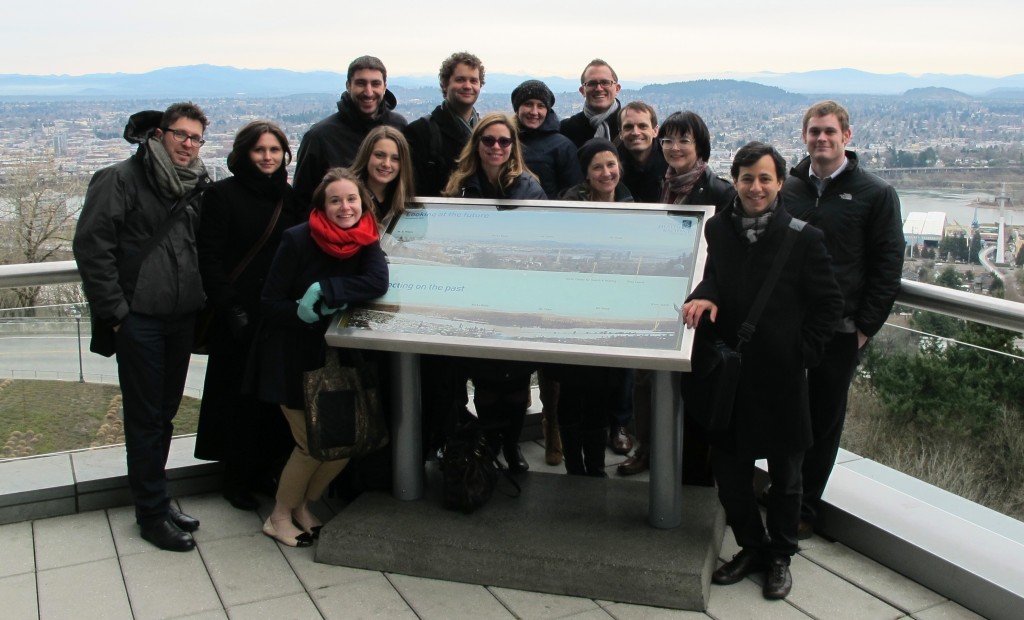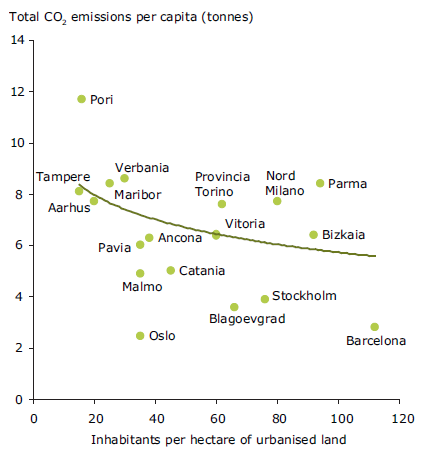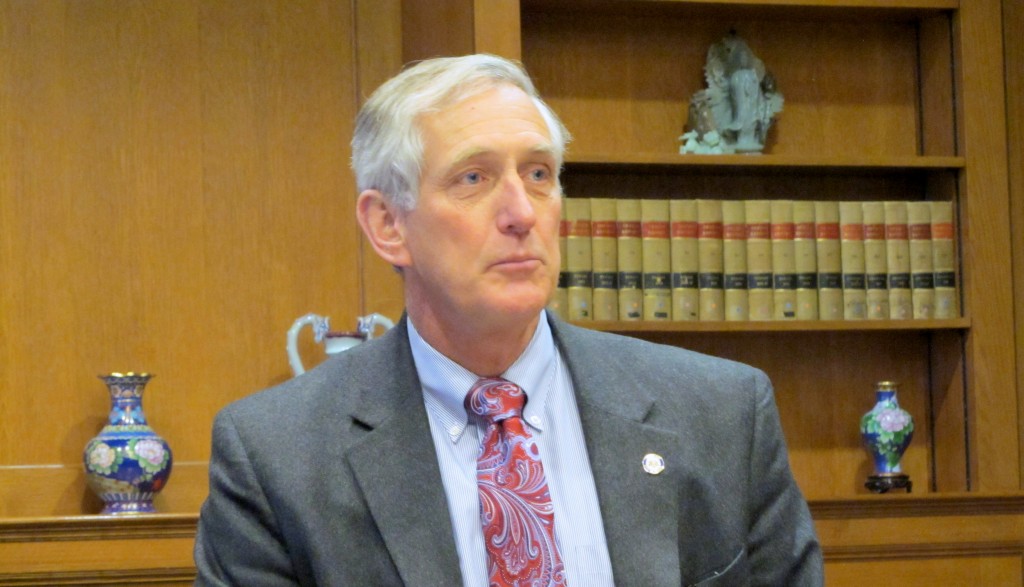The Emerging Leaders in Environmental and Energy Policy (ELEEP) Network brings together young professionals from Europe and North America with the aim of fostering transatlantic relations. Former EGU Science Communications Fellow and ELEEP member Edvard Glücksman reports back from a study tour of the US Pacific Northwest. In this first of two posts, he describes the unique urban planning strategy employed by policymakers in Oregon, giving the state a leading position in the national battle against urban sprawl.

ELEEP members on the Oregon Health & Science University (OHSU) campus looking out over the city of Portland, having just experienced the city’s aerial tramway. (Credit: Edvard Glücksman)
In 2008, for the first time in history, more than half of the human population was living in cities. By 2050, that proportion is expected to grow to 70%. This wave of urban growth is largely seen as beneficial, offering renewed opportunities for jobs, healthcare and education to inhabitants of shrinking rural communities. However, the physical expansion of cities into the countryside, known as urban sprawl, also has major detrimental environmental consequences, damaging and fragmenting natural habitats. That said, CO2 emissions and energy consumption per capita is lower in densely populated cities.

Less densely populated cities have higher CO2 emissions per capita. (Credit: European Environment Agency)
We recently visited the US state of Oregon, where we were shown first-hand how actions taken in the early 1970s by forward-looking policymakers helped mitigate the challenge of urban sprawl before it was too late. As a result, Portland and urban areas across the state are a unique success story in the context of what are otherwise bloated and sprawling North American cities. As urban sprawl hits global headlines, Oregon’s drastic land management strategies may become increasingly relevant in countries where the fight against urban sprawl is only just beginning.

Less densely populated cities also have higher energy consumption per capita. (Credit: European Environment Agency)
Oregon: a state like any other
Oregon’s progressive land use plan stems from the tireless work of Governor Tom McCall in the early 1970s, a man said to have loved Oregon more than life itself. Watching the state’s cities grow in front of his eyes, he told Oregonians they faced a choice between “sagebrush subdivisions and coastal condominiums” and towns that blended gently into the state’s stunning environment. As a result, in 1973 he signed a law requiring every urban area in Oregon to write land use plans that limited sprawl and protected farms, forests and open spaces. Cities were enclosed in strictly enforced urban growth boundaries, with the threat of heavy legal penalties for development beyond designated limits.
Governor McCall’s dramatic influence on his beloved state can today be seen on any map of Oregon’s major urban areas, characterised by the clear divisions between cities and open spaces.
Oregon’s formula for avoiding urban sprawl is remarkably simple yet highly effective, explains Robert Liberty, Director of the Urban Sustainability Accelerator at Portland State University. Liberty has worked with Oregon’s pioneering land use planning program since its inception. His key message is that half a century ago Oregon was developing like every other US state – with population density within cities in decline as urban areas spread across larger spaces, and that a similar transformation can happen anywhere given the right tools for implementation. Getting over the misunderstanding that Oregon is inherently different from other locations in the US forms the core mission statement of the Urban Sustainability Accelerator, which works with other US communities to focus on implementation of land use planning programs.
High quality of life across 20-minute neighbourhoods
Several of our hosts maintain that Oregon, which is relatively poor compared with other US states, owes its success to maintenance of existing infrastructure rather than the urbanisation of untouched countryside. According to Karmen Fore, Transportation Policy Adviser to Governor Kitzhaber at the State Capitol in Salem, this emphasis on maintenance forms an important part of the state’s development strategy.
Looking forward, Fore outlines the state’s other priorities. She explains that Oregon must focus on harnessing its economic strengths, features that make it unique as a hub for business. Although a major expansion to Portland’s shipping port could be imminent, particularly for exports of coal, oil, and natural gas, the state’s spectacular natural environment and quality of life attributes remain at the forefront of such efforts.

A streetcar in downtown Portland. The city’s streetcar network opened in 2001 and currently comprises two lines, with a daily ridership of 13,100 (2012-2013). (Credit: Edvard Glücksman)
Quality of life, according to Fore, is tightly linked to the state’s innovative urban transport systems, particularly in Portland. The city boasts a rich portfolio of commuter trains, buses, light rail, streetcar lines, and even an aerial tramway running throughout the metropolitan area. Across the state, Fore is keen to add more passenger trains, especially on short but important routes, in order to alleviate pressure on congested roads and in the densely crowded US airspace.
Comprehensive transit systems and the preservation of natural landscapes are part of Oregon’s multifaceted, targeted approach, aiming to improve general levels of prosperity and quality of life across the entire population. To that end, Eric Engstrom, Principal Planner for the city of Portland (population 603,106), describes the city’s urban planning strategy as anchored around the concept of the ‘complete community’, or ‘20-minute neighbourhoods’, where every citizen has basic services, parks, healthy food and water, and transportation within a 20-minute walking radius.

The mayor of Portland Charlie Hales meets with ELEEP members to hear a European perspective on urban planning and sustainable transportation. (Credit: Edvard Glücksman)
Learning from Oregon
In the middle of downtown Portland, where once there was a motorway, sits one of the city’s most popular parks, named after Governor McCall. Today, the city has a tight, dense downtown area, friendly to pedestrians aspiring to reduce car use to a minimum in favor of public transportation. The atmosphere is infectious and nearby Seattle, about double as populous, started its urban downsizing in the mid-90s. At City Hall, the mood seems to be one of optimistic realism, with Mayor Charlie Hales quick to point out that the city is a national leader in reduction of urban sprawl yet it still has a long way to go to ensure a sustainable environment for future generations.
Urban sprawl is classically a US phenomenon but is increasingly prevalent across cities worldwide. In Europe, where cities are traditionally more compact than in North America, developing around densely populated historical cores, more cities are threatened with urban sprawl than ever before. By 2020, 80% of Europeans are predicted to live in urban areas, potentially undermining the EU’s efforts to meet carbon emissions reduction targets and drastically altering the quality of life for citizens across the continent. As policymakers grapple with the range of available mitigation strategies, they would be wise to learn from Oregon’s story, the foresight of Governor McCall, and the central principle of the state’s urban transformation; namely, that only a few decisions ago, Oregon was a state like any other.
By Edvard Glücksman, Postdoctoral Research Fellow, University of Duisburg-Essen
ELEEP is a collaborative venture between two non-partisan think tanks, the Atlantic Council and Ecologic Institute, seeking to develop innovative transatlantic policy partnerships. Funding was initially acquired from the European Union’s I-CITE Project and subsequently from the European Union and the Robert Bosch Stiftung. ELEEP has no policy agenda and no political affiliation.




Pingback: GeoLog | Counterintuitive solutions improve public transportation and urban design in Seattle
Pingback: Counterintuitive solutions improve public transportation and urban design in Seattle | GeoLog
Pingback: Improving quality of life through urban growth ...